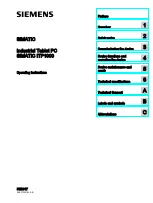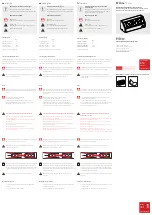
31
switching areas appearing in star (
٭
) symbols (only in the
text section at the bottom of the LCD) or the displayed
values respectively.
•
The setting of functions, values and units is in all modes
performed by use of the switching areas
٭
ON
٭
or
٭
OFF
٭
,
٭
UP
٭
or
٭
DOWN
٭
or by direct unit selection.
•
Advancing to any next respective menu step with
٭
NEXT
٭
,
leaving or terminating all respective modes with
٭
EXIT
٭
.
•
Every programming step activated by touching a switching
area on the Touch Screen is being acknowledged by an
acoustic signal (with buzzer switched ON).
•
If during any process previously activated by use of the
Touch Screen no further action is activated for about 30
seconds the active process is automatically terminated and
switched back to the normal display mode (automatic time
out).
3
Putting into Operation
Note: When putting the Weather Station into operation it is
important to tentatively perform in close proximity (e. g. on
a table) a complete wiring and setup of the system in the
configuration of its prospective use. This measure serves
to test all components for correct function before placing
and mounting them at their final destinations.
3.1
Power supply
The provision of power to the Weather Station can be performed
by use of batteries, or by AC/DC mains adapter
1. Unwind the cable of the Wind sensor. Connect the Wind
sensor to the Thermo-hygro transmitter by plugging the
connector head into the socket of the Thermo-hygro
transmitter.
2. First insert the batteries into the Thermo-hygro transmitter.
3.
Then insert batteries into the
Rain sensor.
4. Insert the batteries into the Weather Station
(or use the
provided AC/DC adapter (power up into a main outlet)
. Once
the batteries are installed, all segments of the LCD will light
up briefly and a short signal tone will be heard. It will then
display the time as
0:00
, the date as
1.1.05
, the weather





































